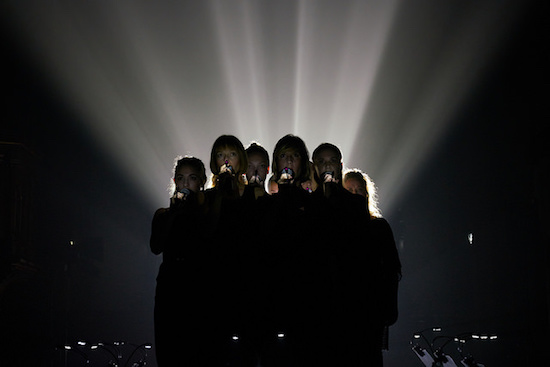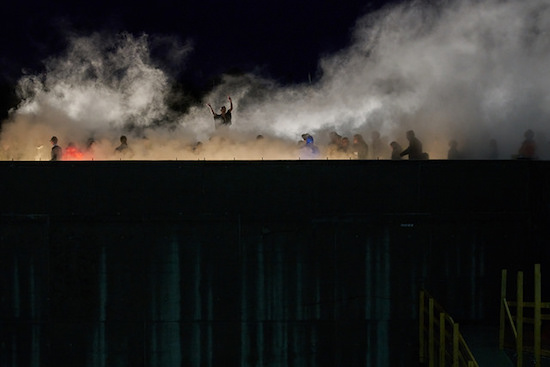Butoh dancer Min Tanaka moving to sound by Ryuichi Sakamoto in a fog installation by Fujiko Nakaya on the roof of Oslo’s new National Museum
“It’s not poo, it’s biomass” says our guide. We are in the second largest waste water treatment plant in Norway, and have descended through concrete corridors to a dank and cavernous space to listen to a generative Arne Nordheim composition. In Norway, every public building has to contain art, it is the law (although my host says that the rise of rightwing politics means this may soon change).
This building, instead of ticking the boxes by putting paintings up in the foyer, instead installed invisible speakers in the watery gloom of the bunker-like plant, which play a set of loops by the late, well-decorated Norwegian composer. The loops are triggered by signals from the workings of the plant. This is a public building but there is no public access. For two years the piece was heard mostly by people who work here, until they got fed up and turned it off except for visits like ours. We walk around in yellow hard hats, listening to the plink-plonk of piano, rushes of concrete sound and the machinery, trying to distinguish the last from the composition, because the speakers are impossible to locate.
It is here, surrounded by waste water, that I am hit by a crushing wave of culture shock. I am talking to a friend from the UK, and we are asking: what is the point of a sound installation in a building which has no public access without prior arrangement? It feels indulgent to my sensibilities, but then a gulf opens up and I see a stark contrast. My socially inherited idea of the value of culture is very different to Norway’s. Norway values culture in a way that we in the UK don’t, values it as something which is important and should be part of daily life.
This cultural chasm lingers throughout Ultima festival. It nags at me, makes me depressed for the place I call home. This is one of the best funded festivals in Europe, and I am spoiled, on a generous delegate programme. I am fed, watered, and given wellies so my feet don’t get wet when it rains. Under these conditions, good shows are utopias made possible by proper cultural funding, bad shows are heinously wasteful. I am particularly baffled by the expense of one directionless sound and live theatre piece titled HANNAH, by Norwegian performance group Verdensteatret. It involves Mondrian-like arrangements of coloured glass, felt-covered speakers, video projections, contact mics, a tuba, Rube Goldberg-like sound-making constructions, some large strips of ambulatory tinfoil and ten performers. It explores ideas around attention fatigue. I write in my notebook: “I wish that had been good, because lunch was lovely.”
Elsewhere, though, the ability to stage larger scale works is a blessing and a triumph: Stian Westerhus performs with the staff band of the Norwegian Armed Forces (in brass buttoned uniforms). Previously he’s been concerned with what it is possible to drag screaming from an electric guitar, but for this show he sings, doing a good impression of a Norwegian Scott Walker in Drift mode. Westerhus whoops his way around lyrics theatrically, although the real thrill is the beautiful confluence of his guitar with the orchestra’s crescendos.
The possibilities for commissioning also deliver for Dwarves Of East Agouza (a trio of Maurice Louca, Sam Shalabi and Alan Bishop) who perform in the heat of a large sauna overlooking Oslo harbour. Everyone is clothed, and the ferocity of their Cairo party music is stifled into a burning hot desert blues jam that is positively in the zone. We cannot move in the heat; the sound and the atmosphere flex and relax, and someone periodically walks to pour water over the two boilers at the front, which emit a loud hiss as the liquid hits the hot coals.
Under a bridge by the train tracks where bikes are parked alongside a building site, Jana Winderen has installed a work that amplifies the sound of rats under the city. Satisfyingly, it draws out the dirt and these skittering sounds from underneath Oslo’s immaculate streets. Maja Ratkje has composed a piece that prods at the meaning and emergence of language, performed by an opera singer and string sections that sounds like rushing wind on heathlands. Sote, an Iranian trio, pull together traditional Iranian instruments and ambient forms. Cikada ensemble are graceful and delicate without being dainty or weak; they play two pieces by Francesco Filideli (including a piece for open strings) and two transpositions of works for piano to strings and wind: Klaus Lang’s final piano piece ‘Schumann’s Geister’ and ‘Nebenstuck’ by Gerard Pesson. The performances are drawn in crisp lines, intermittent rousing phrases half-remembered, like reading billboards from a speeding train.
I am here for four days, but the festival stretches from 7-16 September, and there was much that I missed. Notably, a performance of an Eliane Radigue piece by harpist Rhodri Davies in a mausoleum decorated with naked bodies painted by the man whose ashes are inside.
On the last night of my stay, Supersilent play a 20th anniversary show. The darlings of the Norwegian experimental rock and jazz scene, with 13 albums behind them, they let loose a thunderstorm of industrial sounds, Arve Henriksen cracking his soft, high trumpet out in the midst. But their free cacophony feels toothless, and questions bubble in me around cultural funding returns. How does all this funding fit with quality control? In a stretched system like the UK’s, does the good stuff always make it to the top? These questions broach dangerous territory, around class prejudice, wealth, poverty, difficulty. Does one need poverty, pressure, difficulty to make music that has bite, that has something at stake? The answer should not be yes.

Maja Ratkje and the Trondheim Voices
On the final night the key performance is by butoh dancer Min Tanaka, moving to sound by Ryuichi Sakamoto in a fog installation by Fujiko Nakaya. It takes place on the roof of the new National Museum, which is very much under construction and is still just a concrete shell filled with scaffolding. Rain pools in the stairwells and the routes across the puddles are bridged with plywood.
The cranes above are fixed with floodlights, and they glide back and forth across the scene, silent and sentient. The lights on the roof are a rich golden colour, and the 8pm sky above the harbour is a deep blue. Tanaka is in a kimono, on the edge of the roof, shrouded in Nakaya’s fog. (One of Nakaya’s sculptures was installed behind the Tate Modern earlier this spring.) Tanaka’s movements are those of anxiety, despair and loss, drawn in detail on his sinews, hands slowly grasping at the void, before the fog wheels over him. As it clears, he is revealed leaning back, his body tracing an arc as the mist clears. He looks skyward, and is consumed by fog. Another moment and the hiss of the fog machines envelops us all. I am alone inside a cloud, my hair and eyelashes soaked with fine moisture.
Sakamoto’s sound tracks gestures I cannot see in chimes and rumbles, and I briefly catch sight of Tanaka spinning in the mist, kimono sleeves unfurled, on the cameraphone of someone standing close in the crowd. The images are arresting, paralysing in their cinematic intensity. My mouth hangs open, and ambient sounds slide in, their job here to maintain the illusion, freeze the image in space and time.
Then the mist rolls over Tanaka’s head in soft waves as his head bows, distracted, desperate. Onto these movements enacting sadness, impossibility, difficulty, I suffer a momentary lapse in resolve, overwhelmed by a feeling that music, culture, this work, is too hard in the UK. I think of all the conversations I have had this year with fellow writers, musicians, venues and promoters, about economic anxieties. I think of all those hanging on by a thread, and all the ostensibly successful musicians I know who struggle for basic rent while releasing critically acclaimed work. As Tanaka drops his head into his hands, face creased in pain, shrouded in mist that curls upwards around his shoulders, my heart in my chest swells with the impossibility of it all, and I find myself tearful, for what has already been lost, what is left, and what will not ever be.


